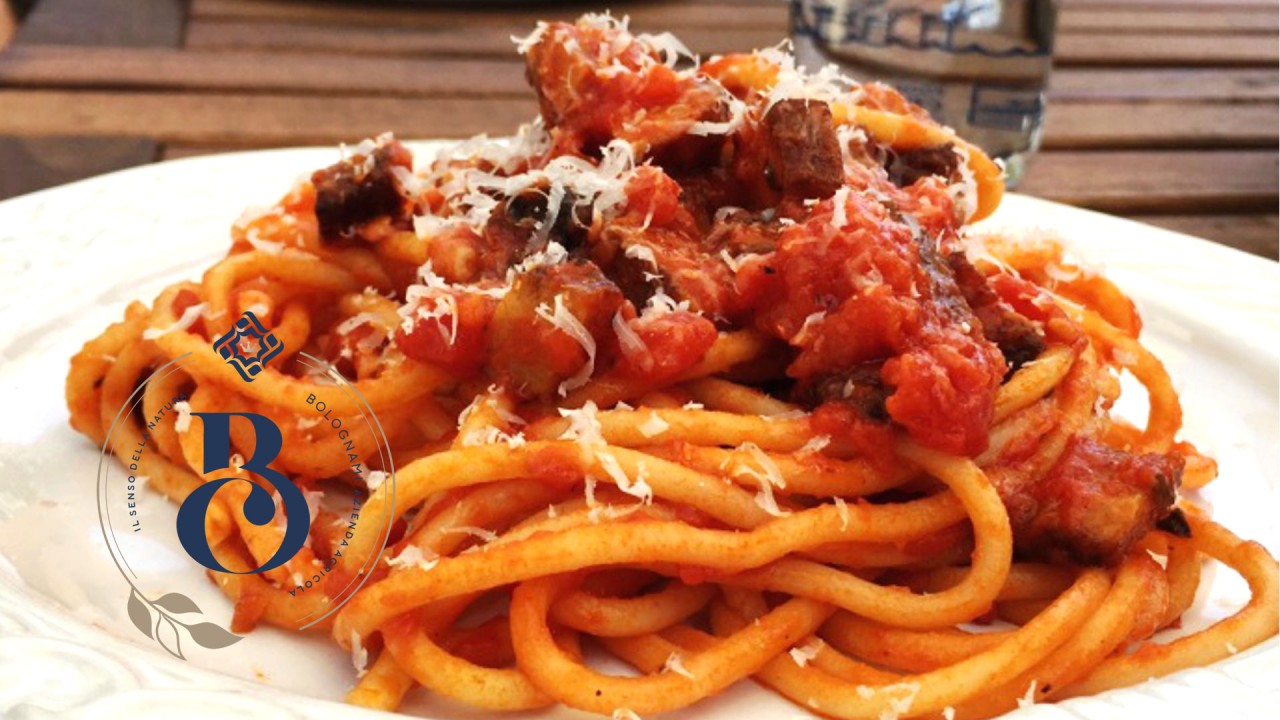
U
mbricelli al Rancetto
Gli Umbricelli al Rancetto sono una tipica ricetta di pasta Umbra. Di antica tradizione, questa pasta è veramente golosa, la preparazione è molto semplice, bastano poche cose ma che devono essere assolutamente di qualità. In ogni zona dell'Umbria, questa pasta prede un nome diverso, si può chiamare Umbricelle, Bigoli o Stringozzi ma è sempre la stessa bontà
Pasta Tradizionale Umbra, Umbricelli al Rancetto
Gli Umbricelli sono dei grossi spaghettoni freschi irregolari e spessi, fatti con farina di grano tenero, come gran parte delle nostre paste artigianali, perché da noi in Umbria, anticamente non si produceva il grano duro, per cui il contadino, una vola, adoperava quello che aveva a disposizione, la farina c'era, l'acqua anche, e pure il sale. Si faceva un impasto con tutti questi ingredienti e si tiravano a mano questi spaghettoni, si condivano con i prodotti che in quel momento erano disponibili, ecco perché questa pasta ha molte ricette diverse dovute anche ai vari periodi dell'anno
Il Significato di Sugo al Rancetto
Il significato di Sugo al Rancetto deriva direttamente dal dialetto Umbro. Siccome uno degli ingredienti principali è il Guanciale di Maiale, in Umbro chiamato Barbozzo (alcuni utilizzano la Pancetta di maiale, può andare bene anche quella), una volta non c'erano i metodi di conservazione degli alimenti che abbiamo oggi, cosi dopo diversi mesi di stagionatura il Guanciale poteva iniziare a diventare un po giallo e cioè rancido. Ma i nostri contadini non buttavano niente, per cui scartando le parti più gialle lo utilizzavano ugualmente, certo il sapore non era perfetto come nei primi mesi di stagionatura e sapeva un po di rancido, ecco da che cosa deriva il nome Rancetto. Oggi, fortunatamente non abbiamo di questi problemi, abbiamo tutto al momento giusto, cosi possiamo gustare al meglio questa meravigliosa ricetta
Ingredienti per gli Umbricelli al Rancetto
Ingredienti per Quattro Persone
500g di Umbricelli Freschi Bolognami
150g di Barbozzo Riserva Norcia Bolognami
300g di Pomodori Pelati
Olio Extra Vergine di Oliva Santa Margherita Bolognami
1 Cipolla Bianca
1 Ciuffo di Maggiorana
Pecorino Stagionato Pilato Il Caseificio di Norcia
Sale Quanto Basta
Pepe Nero Quanto Basta
Preparazione degli Umbricelli al Rancetto
Inizialmente questa ricetta vi può sembrare un Amatriciana, ma é tutta una altra cosa, infatti ci sono il metodo di preparazione ed ingredienti completamente diversi. Per prima cosa prendete i pomodori pelati e privateli dei semi e fateli a pezzetti irregolari. Tagliate il Guanciale (Barbozzo) a listarelle. Tagliate la Cipolla abbastanza fine. Nel Frattempo mettete sul fuoco la pentola con acqua e sale per cuocere la pasta, Mettete in un padella l'Olio e aggiungete la cipolla iniziate a soffriggere a fuoco basso, appena vedete che si è appassita, aggiungete il Guanciale a fate rosolare, quando vedete che è a giusta rosolatura aggiungete i pomodori e fate asciugare, assaggiate e dosate di Sale e Pepe a piacere, aggiungete la Maggiorana e il sugo è pronto. Mettete in acqua gli Umbricelli che in 10-15 minuti saranno pronti, metteteli nella padella del sugo e fateli saltare un attimo, aggiungete il Pecorino grattugiato e Buon Appetito
Il Vino che Consiglio per gli Umbricelli al Rancetto
Per il mio gusto è sicuramente un Vino Bianco come il Grechetto Perticaia, è un bianco fruttato e fragrante che nasce da uve 100% Grechetto provenienti dal cuore verde dell’Umbria. Le vigne si trovano nella zona collinare della campagna attorno a Montefalco, dove oltre a vitigni autoctoni, nella Tenuta si coltiva anche Grechetto, un vitigno storico del centro Italia, che negli ultimi anni si sta sempre più affermando per i suoi caratteri di originalità e piacevolezza di beva. Un vino dal gusto immediato, che conferma non solo le qualità di quest’antica varietà d’uva, ma anche la vocazione dell’Umbria a produrre grandi bianchi. Le vigne per la produzione di questo vino si trovano a un’altitudine di circa 300 m s.l.m., con esposizione sud e Sud/Ovest, in un territorio dal clima fresco e continentale. Nel bicchiere si presenta di colore giallo paglierino con riflessi dorati. Al naso esprime profumi di fiori di campo, aroma di agrumi, di pesca gialla, albicocca ed erbe officinali. In bocca ha un buon corpo, con belle note fruttate, freschezza equilibrata, finale sapido con un leggero sentore di mandorla. Va servito tra i 10-12°C































































































Lascia un Commento